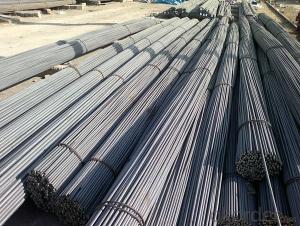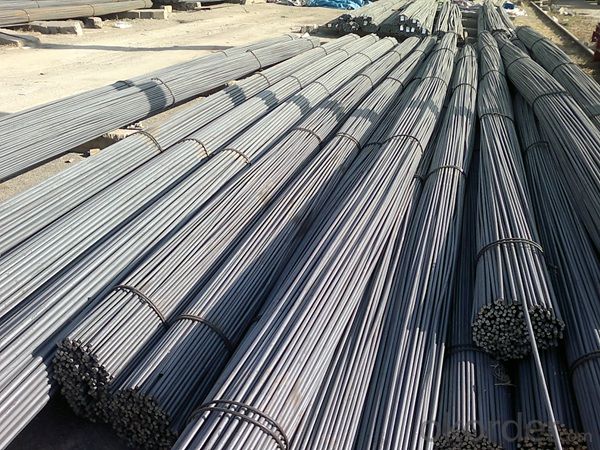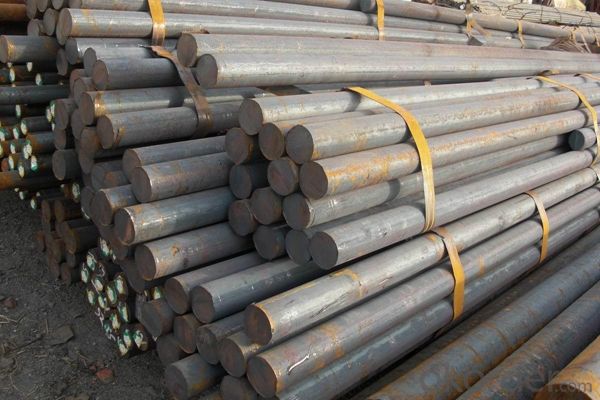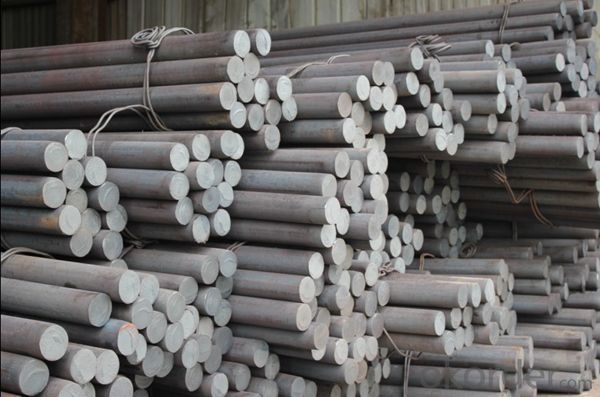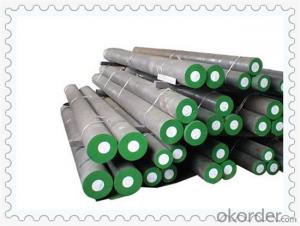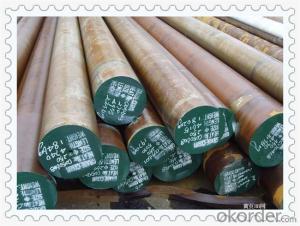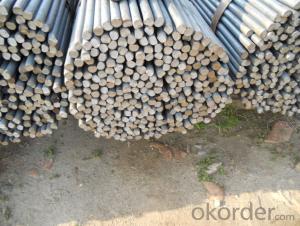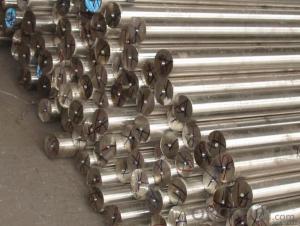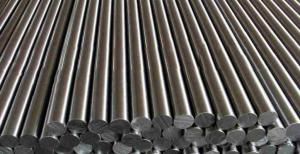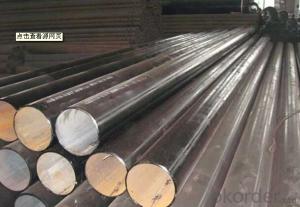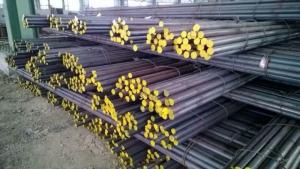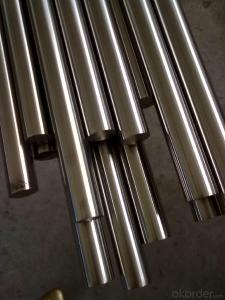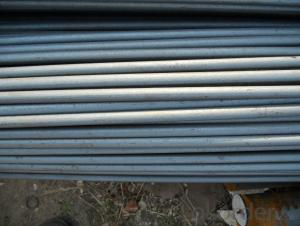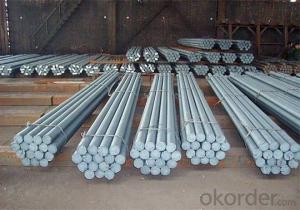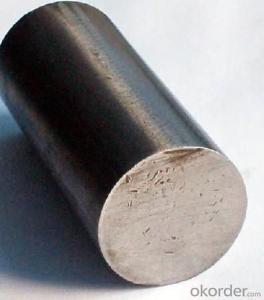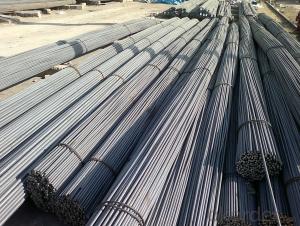Hot Rolled Steel Round Bar for Structure Using
- Loading Port:
- Tianjin
- Payment Terms:
- TT or LC
- Min Order Qty:
- 25 m.t.
- Supply Capability:
- 200000 m.t./month
OKorder Service Pledge
OKorder Financial Service
You Might Also Like
Product Description:
OKorder is offering Hot Rolled Steel Round Bar for Structure Using at great prices with worldwide shipping. Our supplier is a world-class manufacturer of steel, with our products utilized the world over. OKorder annually supplies products to European, North American and Asian markets. We provide quotations within 24 hours of receiving an inquiry and guarantee competitive prices.
Product Applications:
Hot Rolled Steel Round Bar for Structure Using are ideal for structural applications and are widely used in the construction of buildings and bridges, and the manufacturing, petrochemical, and transportation industries. Carbon steel round bar is the most common form of steel because its price is relatively low while it provides material properties that are acceptable for many applications, more so than iron. It is often used when large quantities of steel are needed, for example as structural steel. The density of this product is approximately 7.85g/cm³ and the young's modulus, like all steels.
Product Advantages:
OKorder's Steel I-Beams are durable, strong, and resist corrosion.
Main Product Features:
· Premium quality
· Prompt delivery & seaworthy packing (30 days after receiving deposit)
· Corrosion resistance
· Can be recycled and reused
· Mill test certification
· Professional Service
· Competitive pricing
Specifications of Hot Rolled Steel Round Bar for Structure Using
1. Grade: Q235, SS400, S235JR, A36
2. Sizes: Diameter: 6mm-150mm; Length: 6m, 9m, 12m or as customer’s request
3. Type: Mild steel; Low carbon steel
4. Shape: Round bar, solid bar of steel with circular section
5. Technique: Hot rolled or cold drawn
6. Mass: Mass(kg/m) = Diameter(mm)×Diameter(mm)×0.00617
Steel Type | Maximum forging temperature (°F / °C) | Burning temperature (°F / °C) |
1.5% carbon | 1920 / 1049 | 2080 / 1138 |
1.1% carbon | 1980 / 1082 | 2140 / 1171 |
0.9% carbon | 2050 / 1121 | 2230 / 1221 |
0.5% carbon | 2280 / 1249 | 2460 / 1349 |
0.2% carbon | 2410 / 1321 | 2680 / 1471 |
3.0% nickel steel | 2280 / 1249 | 2500 / 1371 |
3.0% nickel–chromium steel | 2280 / 1249 | 2500 / 1371 |
5.0% nickel (case-hardening) steel | 2320 / 1271 | 2640 / 1449 |
Packaging & Delivery of Hot Rolled Steel Round Bar for Structure Using
Packaging Detail: All goods are packed in bundle with steel strips and shipped by break bulk vessel or container (depend on target market and different ports)
Delivery Detail: 45 days
Trade terms: FOB, CFR, CIF
MOQ: 25 tons per specification; we can negotiate the quantity if the specification is normal or we have stock of one specification.
Weight: The price invoicing on theoretical weight basis or actual weight basis depends on customer’s request.
Shipment: The shipment of bulk break or container is depends on customer’s request and the situation of the port of destination.
Documents given: Full set of original clean on board bill of lading; Original signed commercial invoice; Original packing list; Policy of insurance; Certificate of origin and what the target market needs.
Production Flow of Carbon Steel Round Bar
1. The common processes are preheated forging quenching, dual refinement solution process, cooling quenching and isothermal quenching. We use heat treatment for dual refinement solution process. The main measures process is high temperature solution and refinement cycle. High temperature solution can improve the carbide morphology and particle size. The aim is to make the loop refinement ultrafine austenite grains.
2. EAF+LF+VD+ Forged+ Heat Treatment
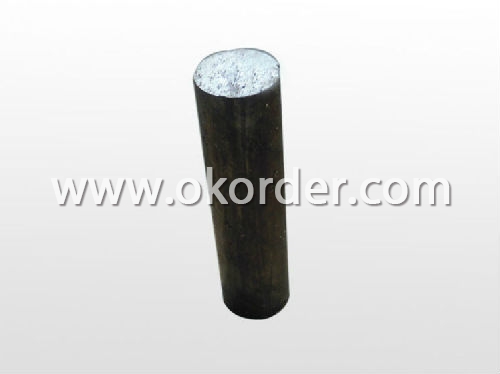
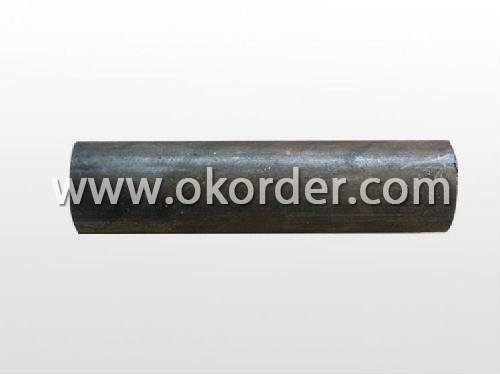
FAQ:
Q1: Can fit in the containers of 20fts the steel beams of 6M?
A1: No proble, we can put them into the containers in the form sideling.
Q2: What is the normal tolerance of Hot Rolled Mild Steel Angle Beams for Structures and for Buildings?
A2: Normally 3%-5%, but we can also produce the goods according to the customers' requests.
Q3: The products are invoicing on theoritical weight or on actual weight?
A3: We can do it in both manners, according to the customers' request.
- Q: What are the advantages of using bearing steel round bars?
- There are several advantages of using bearing steel round bars: 1. High strength and durability: Bearing steel round bars are known for their exceptional strength and durability. They are specifically designed to withstand heavy loads and high impact forces, making them ideal for applications that require a reliable and robust material. 2. Excellent wear resistance: Bearing steel round bars have excellent wear resistance properties, which means they can endure constant friction and abrasion without experiencing excessive wear and tear. This makes them suitable for applications where the material needs to withstand repetitive rotational motion or sliding. 3. Superior hardness: Bearing steel round bars are typically heat-treated to achieve optimal hardness levels. This hardness allows them to maintain their shape and structural integrity even under extreme conditions, such as high temperatures or heavy loads. 4. Dimensional stability: Bearing steel round bars exhibit excellent dimensional stability, meaning they maintain their shape and size even under varying temperature and environmental conditions. This quality is crucial in applications where precise dimensions are required to ensure proper functioning and performance. 5. Corrosion resistance: Bearing steel round bars are often alloyed with elements like chromium and molybdenum, which enhance their corrosion resistance. This makes them suitable for use in corrosive environments, such as marine or chemical industries. 6. Machinability: Bearing steel round bars are relatively easy to machine and process, which allows for efficient production and customization. This makes them a cost-effective choice for various applications, as they can be easily shaped, cut, or drilled according to specific requirements. Overall, the advantages of using bearing steel round bars include their high strength, excellent wear resistance, superior hardness, dimensional stability, corrosion resistance, and machinability. These qualities make them a preferred choice in industries such as automotive, aerospace, machinery, and construction, where reliability, durability, and performance are crucial.
- Q: How do you cut steel round bars?
- To cut steel round bars, there are several methods that can be used depending on the specific requirements and available tools. Here are a few common techniques: 1. Abrasive Cutting: This method involves using an abrasive cutting wheel or disc, usually mounted on a handheld angle grinder or a chop saw. The round bar is secured in place, and the cutting wheel is applied to create a groove on the bar's surface. By applying pressure and rotating the bar, the cutting wheel gradually cuts through the steel. 2. Cold Saw: A cold saw is a specialized machine used for cutting metal. It has a circular blade that operates at a low speed, reducing heat generation during the cutting process. The round bar is securely clamped in place, and the cold saw's blade is lowered onto the bar, cutting through it with precision. 3. Band Saw: A band saw is another machine commonly used to cut steel round bars. It consists of a continuous toothed metal band that rotates on two pulleys. The round bar is secured in a vise, and the band saw is adjusted to the desired cutting angle and speed. The bar is then fed into the blade, which cuts through it smoothly. 4. Torch Cutting: For thicker steel round bars, oxy-fuel torch cutting can be employed. This method involves using a torch that combines oxygen and fuel gas, such as acetylene, to generate a high-temperature flame. The round bar is heated until it reaches a molten state, and then a separate stream of oxygen is directed onto the heated region, causing the steel to oxidize rapidly and form a cut. Regardless of the method used, it is crucial to take proper safety precautions, such as wearing protective goggles, gloves, and ensuring a stable work surface. Additionally, using the appropriate cutting tools and techniques for the specific type of steel being cut is essential to achieve clean and precise cuts.
- Q: Can steel round bars be used for making springs?
- Yes, steel round bars can be used for making springs. Steel is a widely used material for springs due to its high strength and durability. Steel round bars can be shaped into various types of springs, including compression springs, extension springs, and torsion springs. The round bar can be cut to the desired length and then heat-treated to achieve the desired hardness and springiness. The specific type of steel and the heat treatment process will determine the spring's characteristics, such as its load-bearing capacity, flexibility, and resistance to fatigue. However, it is important to note that the design and engineering of springs require careful consideration of factors such as the required spring rate, maximum load, and operating conditions to ensure the optimal performance of the spring.
- Q: What are the different heat treatment processes used for steel round bars?
- Some of the different heat treatment processes used for steel round bars include annealing, quenching, tempering, normalizing, and hardening. Each process involves heating and cooling the steel to alter its properties such as hardness, strength, and ductility. Annealing involves heating the steel and slowly cooling it to relieve internal stresses and improve machinability. Quenching involves rapidly cooling the steel to increase its hardness. Tempering is a process that involves reheating the quenched steel to reduce brittleness and improve toughness. Normalizing is similar to annealing but involves air cooling instead of slow cooling. Hardening is a process that involves heating the steel and then rapidly cooling it to increase its hardness and strength.
- Q: Can steel round bars be used for making architectural or decorative elements?
- Certainly, steel round bars are an excellent choice for crafting architectural or decorative elements. These bars possess numerous advantages that render them perfect for such applications. To begin with, steel is an enduring and robust material, guaranteeing the longevity and stability of the architectural or decorative element. Moreover, steel round bars can be easily manipulated and personalized to fashion intricate designs, making them adaptable for various architectural styles and aesthetics. These bars can be employed to produce features such as railings, balustrades, ornamental gates, sculptures, or even pieces of furniture. Additionally, the sleek and polished surface of the steel round bars enhances their visual allure, rendering them ideal for decorative purposes. Furthermore, steel is resistant to corrosion, ensuring that the architectural or decorative element will remain intact and visually pleasing even in outdoor or high-moisture environments. In conclusion, steel round bars are a fitting and sought-after option for creating architectural or decorative elements owing to their durability, versatility, and visual appeal.
- Q: How do you store excess steel round bars?
- To store excess steel round bars, it is important to follow certain guidelines to ensure their longevity and prevent any damage. Here are a few steps you can take: 1. Properly clean and inspect the steel round bars before storage. Remove any dirt, grease, or moisture from the surface to prevent corrosion. 2. Choose an appropriate storage location. Ideally, it should be a dry, well-ventilated area with stable temperatures. Avoid storing the bars in areas prone to moisture, extreme heat, or direct sunlight. 3. Use racks or pallets to store the bars. Stack them horizontally, one on top of another, with enough space between each layer to prevent deformation or bending. 4. If storing the bars outdoors, cover them with a waterproof tarp or protective coating to shield them from rain, snow, and other elements. 5. Avoid placing excessive weight on top of the bars to prevent deformation. Be mindful of any sharp objects or edges nearby that could cause damage. 6. Regularly inspect the stored bars to ensure no signs of corrosion, rust, or other damage. If any issues are detected, take the necessary steps to address them promptly. Remember, proper storage is crucial to preserve the quality and integrity of the steel round bars. By following these guidelines, you can ensure that your excess steel round bars remain in good condition until they are needed for future use.
- Q: What are the different grades of steel round bars?
- There are several different grades of steel round bars, each with its own unique properties and characteristics. Some of the most common grades include: 1. Mild Steel: Also known as low carbon steel, this grade is the most widely used due to its affordability and versatility. It has a relatively low carbon content and is easy to weld and form. 2. Carbon Steel: This grade contains a higher carbon content than mild steel, making it stronger and more durable. It is commonly used in applications that require high strength and hardness, such as construction and machinery. 3. Alloy Steel: Alloy steel round bars are made by combining different elements, such as chromium, nickel, or molybdenum, with carbon steel. This creates a material with enhanced properties, such as increased corrosion resistance, improved toughness, and higher tensile strength. 4. Stainless Steel: Stainless steel round bars are made primarily from iron and contain a minimum of 10.5% chromium. This grade of steel is known for its excellent corrosion resistance and is commonly used in applications where hygiene and cleanliness are crucial, such as in the food and pharmaceutical industries. 5. Tool Steel: Tool steel round bars are specifically designed to withstand high temperatures, heavy loads, and repeated impacts. They have excellent hardness, wear resistance, and toughness, making them suitable for manufacturing tools and dies. 6. High-Speed Steel (HSS): HSS round bars are a type of tool steel that can withstand high cutting speeds without losing their hardness. They are commonly used in applications that involve cutting, drilling, or machining at high speeds, such as in the manufacturing of drills and milling cutters. These are just a few of the many grades of steel round bars available, each designed to meet specific requirements in various industries and applications. It is important to select the appropriate grade based on factors such as strength, corrosion resistance, and desired properties for a particular project or usage.
- Q: How do I calculate the length of a steel round bar based on weight?
- To calculate the length of a steel round bar based on weight, you would need to know the density of the steel and its cross-sectional area. The formula to calculate the length is weight divided by (density multiplied by cross-sectional area).
- Q: What is the difference between a hot-rolled and a ground steel round bar?
- A hot-rolled steel round bar is produced through a process called hot rolling, where the steel is heated above its recrystallization temperature and then passed through rollers to achieve the desired shape and size. This method results in a rough surface finish with a scaled or uneven texture. Hot-rolled steel round bars are commonly used in construction, manufacturing, and general fabrication applications where a smooth finish is not a primary concern. On the other hand, a ground steel round bar undergoes a process called grinding after the initial hot rolling. Grinding involves removing the outer layer of the hot-rolled bar to create a smooth and consistent surface finish. This process eliminates any imperfections, such as scale or unevenness, to provide a more precise and refined product. Ground steel round bars are often utilized in applications where a smooth surface finish is crucial, such as in machining, toolmaking, and precision engineering. In summary, the main difference between a hot-rolled and a ground steel round bar lies in the surface finish. Hot-rolled bars have a rough and uneven texture, while ground bars have a smooth and consistent surface. The choice between the two depends on the specific application and the desired level of surface finish required.
- Q: Can steel round bars be used for making sway bars?
- Yes, steel round bars can be used for making sway bars. Sway bars, also known as stabilizer bars or anti-roll bars, are used in vehicles to reduce body roll and improve stability when cornering. Steel round bars are commonly used for this purpose due to their high strength and durability. The round shape allows for even distribution of forces and provides torsional stiffness, which is crucial for sway bars to effectively control body roll. Additionally, steel is readily available, cost-effective, and can be easily fabricated into the desired shape and size for sway bar applications.
Send your message to us
Hot Rolled Steel Round Bar for Structure Using
- Loading Port:
- Tianjin
- Payment Terms:
- TT or LC
- Min Order Qty:
- 25 m.t.
- Supply Capability:
- 200000 m.t./month
OKorder Service Pledge
OKorder Financial Service
Similar products
Hot products
Hot Searches
Related keywords
